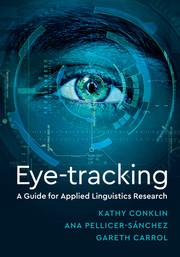Book contents
- Frontmatter
- Contents
- Figures
- Tables
- Preface
- Chapter 1 Introduction to Eye-Tracking
- Chapter 2 Choosing the Equipment
- Chapter 3 Practicalities of Eye-Tracking
- Chapter 4 Researching Reading
- Chapter 5 Researching Listening and Multimodal Input
- Chapter 6 Using Eye-Tracking in Other Contexts
- Chapter 7 Working with the Data
- Chapter 8 Conclusions
- References
- Index
4 - Researching Reading
Published online by Cambridge University Press: 14 September 2019
- Frontmatter
- Contents
- Figures
- Tables
- Preface
- Chapter 1 Introduction to Eye-Tracking
- Chapter 2 Choosing the Equipment
- Chapter 3 Practicalities of Eye-Tracking
- Chapter 4 Researching Reading
- Chapter 5 Researching Listening and Multimodal Input
- Chapter 6 Using Eye-Tracking in Other Contexts
- Chapter 7 Working with the Data
- Chapter 8 Conclusions
- References
- Index
Summary
Introduction
Reading is a relatively recent development in human history, existing for only a few thousand years (Immordino-Yang and Deacon, 2007). However, it has become an essential life skill in modern society, one that is developed over many years of exposure, formal instruction and practice. Good reading skill underpins academic achievement (for a discussion see Renandya, 2007), and for second language learners, reading is a gateway to learning new vocabulary, more colloquial language and new grammatical constructions (Wilkinson, 2012). As Huey summarised over a hundred years ago, and which is still as true today, gaining a complete understanding of reading – how we learn to read, how we become fluent readers, how to best teach reading, etc. – is an important aspiration.
And so to completely analyse what we do when we read would almost be the acme of a psychologist's dream for it would be to describe very many of the most intricate workings of the human mind, as well as to unravel the tangled story of the most remarkable performance that human civilization learned in all of its history.
(Huey, 1908, p. 6)We know that for readers the primary goal is to identify words, ascertain their meaning and integrate them into their unfolding understanding of a sentence and/or larger discourse. However, what exactly happens when we read? How do our eyes move? Do we look at every word when we read? Eye-tracking has allowed us to gain a fairly comprehensive understanding of what happens during reading and the factors that impact it, which will be an important focus in this chapter. As we will see more explicitly in Sections 4.3–4.6, a good understanding of both of these is fundamental to our ability to create well-designed studies.
As we saw in Chapter 1, reading involves a series of ballistic eye-movements (saccades), brief pauses (fixations) and movements back to previous parts of a text (regressions). Saccades occur largely due to the limitations of the visual system. More precisely, vision is ‘clear’ around a fixation, but clarity decreases moving away from it. This situation is depicted in Figure 4.1. In example (a) when the eyes fixate ‘reader’, this word is clear, making it easy to identify. Moving away from this point, vision becomes progressively less sharp.
- Type
- Chapter
- Information
- Eye-TrackingA Guide for Applied Linguistics Research, pp. 80 - 111Publisher: Cambridge University PressPrint publication year: 2018



